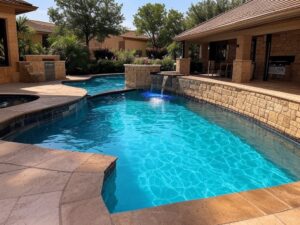A green pool fix typically indicates an algae bloom, requiring immediate attention through proper chemical balance, shock treatment, and filtration. The entire green pool repair takes 2-5 days, including trying out, shocking, brushing, and filtering until the water returns to its crystal-clear nature.
Whether you’ve returned from an excursion to discover a swamp-like scene or woken up to an emerald marvel, this comprehensive guide will walk you through every step to reclaim your pool’s pristine situation.
Understanding Why Pools Turn Green
The transformation of your pool from clean to inexperienced typically stems from algae boom, which thrives in heat, nutrient-rich environments. Poor stream, insufficient sanitizer degrees, and imbalanced chemistry create the best situations for these microscopic organisms to multiply rapidly.
Weather modifications, specially all through summer months, can accelerate algae boom. Rain dilutes pool chemicals while bringing additional nutrients, creating an ideal breeding ground for algae. Understanding these factors helps prevent future occurrences while addressing the current situation.
Types of Pool Algae
Different algae species create varying shades of green and require specific treatment approaches. Light green usually indicates common free-floating algae, while darker shades might suggest more stubborn variants attached to pool surfaces.
Mustard algae appears yellowish-green and often gets mistaken for dirt, while black algae forms tough colonies that resist standard treatments. Identifying the specific type helps determine the most effective treatment strategy.
Essential Testing Before Treatment
Begin your green pool fix by testing all crucial chemical parameters. Accurate readings of chlorine, pH, alkalinity, and cyanuric acid levels provide the foundation for effective treatment.
Use fresh testing strips or liquid test kits for reliable results. Digital testers offer precise readings but ensure proper calibration. Record all measurements to track progress throughout the treatment process.
Understanding Test Results
Normal ranges for pool chemistry include pH between 7.2-7.6, free chlorine at 1-3 ppm, and total alkalinity between 80-120 ppm. Algae-infected pools often show inadequate chlorine levels and high pH.
Cyanuric acid levels shouldn’t exceed 50 ppm, as higher concentrations can reduce chlorine effectiveness. Understanding these relationships helps optimize treatment efficiency and prevent future problems.
Initial Treatment Steps
Start by removing large debris using a pool net or vacuum. This step prevents organic matter from consuming shock chemicals and ensures better circulation during treatment.
Brush the entire pool surface thoroughly, including walls, floor, and corners. This action dislodges algae colonies and allows chemicals to work more effectively.
Chemical Balance Adjustment
Begin chemical adjustments by balancing pH and alkalinity. Add acid if pH exceeds 7.6, as lower pH improves chlorine efficiency against algae.
Balance total alkalinity to prevent pH fluctuations during treatment. This stability ensures consistent chemical effectiveness throughout the green pool fix process.
Shock Treatment Process
Calculate the appropriate shock dosage based on pool volume and algae severity. Severe cases might require triple-shock treatment, using 3 pounds of shock per 10,000 gallons.
Apply shock during evening hours to prevent sun degradation. Distribute chemicals evenly around the pool’s perimeter while the pump runs for optimal distribution.
Post-Shock Procedures
Continue running the filter system 24/7 during treatment. Clean or backwash the filter daily to remove captured algae and prevent system strain.
Monitor chemical levels daily, adjusting as needed. Maintain elevated chlorine levels until water clarity improves and all algae signs disappear.
Filtration and Circulation
Ensure proper filter operation by checking pressure gauges and flow rates. Clean or replace filter media if necessary to maintain optimal performance.
Position return jets to create circular water movement. This pattern prevents dead spots where algae might survive treatment.
Filter Maintenance During Treatment
Backwash sand or DE filters when pressure rises 8-10 psi above normal. For cartridge filters, clean thoroughly with filter cleaner solution.
Monitor pump operation for consistent flow. Address any air leaks or prime issues promptly to maintain effective circulation.
Water Clarity Management
As treatment progresses, use clarifier to help coagulate suspended particles. This process speeds up filtration and improves water clarity.
Consider using flocculant to drop suspended matter to the pool floor for easier vacuum removal. This step often accelerates the clearing process.
Vacuum and Debris Removal
Vacuum settled debris to waste, bypassing the filter system. This method prevents recirculating fine particles through the pool.
Clean skimmer and pump baskets regularly to maintain proper flow. Remove any debris that might reduce circulation efficiency.
Prevention Strategies
Implement regular maintenance schedules including chemical testing, brushing, and filter cleaning. Consistent care prevents most algae problems before they start.
Maintain proper chemical levels year-round, especially during peak swimming season. Regular shock treatments help prevent algae growth even during optimal conditions.
Long-term Maintenance Tips
Install a quality pool cover for periods of non-use. Covers reduce contamination and chemical consumption while maintaining better water balance.
Consider automated chemical feeders or salt chlorine generators for consistent sanitizer levels. These systems help prevent the conditions that lead to algae growth.
Troubleshooting Common Issues
Address persistent cloudy water by checking filter operation and chemical balance. Sometimes, additional clarifier or time is needed for complete clearing.
Handle resistant algae spots with spot treatment using liquid chlorine and brushing. Pay special attention to shaded areas and corners where algae often persists.
When to Seek Professional Help
Consider professional service if water remains green after several days of treatment. Experts can identify underlying issues and provide specialized solutions.
Consult professionals for equipment problems or unusual situations beyond basic treatment protocols. Their experience often saves time and chemicals in difficult cases.
Cost Considerations
Budget for necessary chemicals including shock, clarifier, and algaecide. Quality products often provide better results despite higher initial costs.
Factor in equipment operation costs, especially during extended filter runs. Consider energy-efficient equipment for long-term savings.
Value of Prevention vs. Treatment
Compare routine maintenance costs with emergency treatment expenses. Regular care typically costs less than addressing severe algae problems.
Invest in quality testing supplies and basic chemicals for immediate response to early signs of problems. Quick action prevents most serious algae situations.
Environmental Considerations
Choose environmentally friendly treatment options when possible. Some algaecides and clarifiers offer eco-friendly formulations without sacrificing effectiveness.
Consider salt systems or mineral purifiers to reduce chemical usage. These alternatives often provide more stable water chemistry with less environmental impact.
Safety Precautions
Store pool chemicals properly in cool, dry locations. Keep oxidizers separated from other products to prevent dangerous reactions.
Use appropriate safety gear including gloves and eye protection when handling chemicals. Follow all manufacturer guidelines for proper chemical handling and application.
Final Steps and Verification
Confirm complete algae elimination through visual inspection and testing. Water should be crystal clear with no visible green tints or particles.
Verify chemical balance within normal ranges before resuming regular maintenance schedule. Document successful treatment steps for future reference.
Return to Normal Operation
Resume standard chemical levels and filtration schedules gradually. Monitor conditions closely for several days to ensure stability.
Update maintenance procedures based on experience, incorporating preventive measures to avoid future algae problems.
Through this comprehensive approach to green pool fix, you’ll restore your pool’s clarity and maintain its pristine condition throughout the swimming season. Remember that prevention through regular maintenance usually requires less effort and expense than treating severe algae problems.
Frequently Asked Questions about Green Pool Fix
- How to green pool fix quickly?
For a green pool fix, start by testing the water, brushing the walls, and shocking it with 3 lbs of chlorine per 10,000 gallons. Run the filter 24/7 and ensure the pH stays between 7.2 and 7.6 until the water clears up. - How do I bring my green pool back to life?
Start by removing debris, balancing chemicals, and performing a triple-shock treatment at night for a green pool fix. Afterward, brush the pool thoroughly and run the pump continuously until the water sparkles. This combination of steps will help restore your pool’s clarity and health, transforming it into a sparkling oasis. - How do I get rid of the green tint in my pool?
To fix a green pool, apply algaecide, maintain chlorine levels at 3ppm, brush daily, and keep the filter running until water clarity returns. By consistently following these steps, you’ll ensure a thorough green pool fix, restoring the water’s clarity and making it safe for swimming.
- How to make pool water clear?
First, balance pH and alkalinity, shock treat with chlorine, and add water clarifier. To achieve a complete Green Pool Fix, vacuum debris and filter continuously until the water becomes crystal clear.




